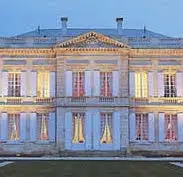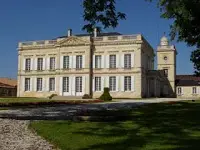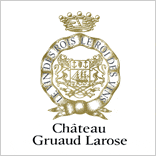The King of Wines, The Wine of Kings is the motto of the Saint  Julien Second Growth Chateau Gruaud Larose and is embossed on its label to this day (Le Roi des Vins, le Vin des Rois). The earliest written records of Gruaud Larose date back to the early 1700s when the Chevalier (Knight) Joseph Stanislas Gruaud owned the land.
Julien Second Growth Chateau Gruaud Larose and is embossed on its label to this day (Le Roi des Vins, le Vin des Rois). The earliest written records of Gruaud Larose date back to the early 1700s when the Chevalier (Knight) Joseph Stanislas Gruaud owned the land.
In the 1750s Gruaud Larose was well established and its wine sold for higher prices than all but the four First Growths: Chateaux Lafite, Latour, Margaux and Haut Brion (Mouton did not become a First Growth until 1973).
Gruaud Larose lies inland from Châteaux Ducru Beaucaillou and Beychevelle and its 189 acres of vineyards are sandwiched between the vineyards of Chateaux Branaire Ducru and Lagrange.
The grape varieties planted are 57% Cabernet Sauvignon, 30% Merlot, 8% Cabernet Franc, 3% Petit Verdot and 2% Malbec. The soil is a layer of Garonne gravel (Günz) over chalk and clay. The geological structure of the soil at Gruaud Larose is particularly rare as it has a uniform layer of gravelly clay 6 metres deep over the entire estate.
30% Merlot, 8% Cabernet Franc, 3% Petit Verdot and 2% Malbec. The soil is a layer of Garonne gravel (Günz) over chalk and clay. The geological structure of the soil at Gruaud Larose is particularly rare as it has a uniform layer of gravelly clay 6 metres deep over the entire estate.
In the latter part of the 1700s two descendants of Joseph Stanislas, one a Magistrate and the other an Abbot, were responsible for adding to the vineyard of  Gruaud Larose, incorporating the separate estates of Tenac, Sartaignac and du Merle, forming an estate named Fombedeau.
Gruaud Larose, incorporating the separate estates of Tenac, Sartaignac and du Merle, forming an estate named Fombedeau.
This name was soon changed to that of “Gruaud,” following the custom of baptising a growth with the name of its proprietor.
Two wines were produced from the estate: Abbé Gruaud and Chevalier de Gruaud. The Magistrate was a colourful character and was renowned for his eccentricity.
He built a tower so that he could watch over the workers in the vineyards and each year he would hoist a flag at the top of it. A German flag indicated that the vintage that year was soft and supple, a British flag meant that it was firm and full bodied and a Dutch flag showed that the wine was somewhere between the two.
He would also cause a stir by selling his wines by auction in the centre of Bordeaux. He would often escalate prices and his wines would sell out.
out.
When the Magistrate died in 1778 his part of the property was inherited by his son in law Joseph Sebastian de La Rose, President of one of the Minor Law Courts and Lieutenant General de la Senechaussee de Guyenne, who also owned Chateau Larose Trintaudon – one of the largest estates in Bordeaux.
La Rose added his name to the chateau, giving us the current name of Gruaud Larose and was responsible for creating the wines popularity within the higher echelons of society at this time.
A book written a century ago states that: “the wine acquired a  considerable renown, being in evidence on the tables of royalty and the nobility, and thus worthily bearing the device: ” Le Roi des Vins.” (The King of Wines). ” Le Vin des Rois.” (The Wine of Kings).” The author goes on to say that the chateau “verily surpasses those of the first growths”.
considerable renown, being in evidence on the tables of royalty and the nobility, and thus worthily bearing the device: ” Le Roi des Vins.” (The King of Wines). ” Le Vin des Rois.” (The Wine of Kings).” The author goes on to say that the chateau “verily surpasses those of the first growths”.
The wines of Gruaud Larose found fame outside France in England, Germany, Austria, Holland, Belgium, and were even shipped to the USA. Thomas Jefferson favoured them and called them the ‘Old Gruaud Wines’.
The chateau remained with the La Rose family until 1812 when the property was auctioned off due to the failure of the heirs to agree on the division of the estate upon their inheritance. This resulted in the estate becoming divided into two: Gruaud Larose Sarget and Gruaud Larose Faure. In 1917 the negotiant Désiré Cordier, purchased Gruaud Larose Sarget and seventeen years later, in 1934, when the opportunity arose to purchase Gruaud Larose Faure, Cordier bought all the shares and reunified the chateau.
Today Gruaud Larose has been in the hands of the Taillan Group since 1997. The Group, which includes the Villars family, also own Chateaux Chasse Spleen, La Gurgue, Haut Bages Liberal, Citran, Broustet and Ferrière as well as the negotiants Ginestet, the Compagnie Rhodanienne (Rhone Valley), Joseph Verdier (Loire Valley), properties in Cahors, British Columbia’s Okanagan Valley (Canada) and a 50% stake in the Taillan Winery in China based near Beijing. The Win ery was founded in 1996 and is a joint-venture with the Chinese company Sunyuan. Today they produced small quantity of wines from Malbec and Chardonnay overseen by oenologist Alain Leroux.
ery was founded in 1996 and is a joint-venture with the Chinese company Sunyuan. Today they produced small quantity of wines from Malbec and Chardonnay overseen by oenologist Alain Leroux.
In 2007 Eric Boissenot (who consults with his renowned father, Jacques) joined Gruaud Larose as consulting oenologist. Jacques Boissenot is also the oeonologist for the First Growths Chateaux Latour, Lafite and Margaux. Robert Parker gave the 2009 vintage 92 – 94+ points, saying:
“This is the finest Gruaud Larose since the 1990. Without a hint of brett in the 2009, it exhibits an opaque purple colour along with a big, sweet nose of crème de cassis, new saddle leather, spice box, and boysenberries.
Made in a rich, broad, savoury, juicy style with lots of succulence, but none of the masculinity and ruggedness often found in this offering, this wine is loaded with concentration and extract. The tannins are largely concealed by the remarkable intensity of fruit and density. It should be drinkable in 7-8 years, and last for 30-40.”
of the masculinity and ruggedness often found in this offering, this wine is loaded with concentration and extract. The tannins are largely concealed by the remarkable intensity of fruit and density. It should be drinkable in 7-8 years, and last for 30-40.”
The chateau makes a Second Wine: Sarget du Chateau Gruaud Larose and a Third Wine Larose de Gruaud which are well worth looking out for. Gruaud Larose remains one of Saint Julien’s most popular wines – its large production has a quality that is consistently very high and it is one of the most continuously successful wines produced in Bordeaux, regardless of vintage.


